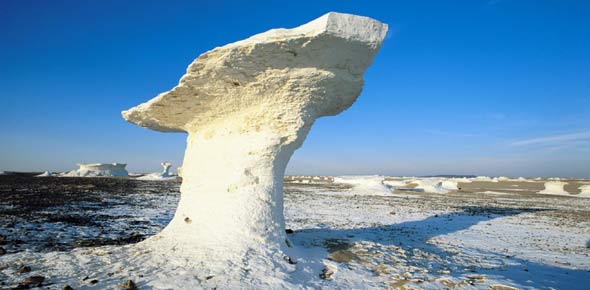Weathering, Erosion, And Deposition Quiz

Questions and Answers
- 1.
What is weathering??
- A.
The force of wind
- B.
The moving of rock
- C.
The dropping of rock
- D.
The break of rock
Correct Answer
D. The break of rockExplanation
Weathering refers to the process of breaking down and wearing away of rocks, minerals, and other substances on the Earth's surface. It is caused by various factors such as temperature changes, water, wind, and biological activity. The break of rock accurately describes the process of weathering as it involves the physical and chemical breakdown of rocks into smaller fragments, which can be caused by factors like freezing and thawing, abrasion, and the expansion of roots.Rate this question:
-
- 2.
What is deposition?
- A.
The move of sand
- B.
The drop of sediment
- C.
The move of rock
- D.
The breaking of rock
Correct Answer
B. The drop of sedimentExplanation
Deposition refers to the process of sediment being dropped or settled in a new location. When sediment is transported by wind, water, or ice, it eventually loses its energy and comes to rest. This settling down of sediment is known as deposition. It can occur in various environments such as rivers, beaches, and deltas, where sediments are carried and then deposited. Therefore, the correct answer is "The drop of sediment."Rate this question:
-
- 3.
What is Erosion?
- A.
The gradual wearing away of soil, rock, or other materials by natural agents.
- B.
The process of water droplets falling from the sky.
- C.
The formation of landforms such as sea arches.
- D.
The force exerted by wind on the Earth's surface.
Correct Answer
A. The gradual wearing away of soil, rock, or other materials by natural agents.Explanation
Erosion refers to the process by which soil, rock, or other materials are gradually worn away by the action of water, wind, or other natural agents. This process involves the transportation of sediment from one location to another, leading to changes in the landscape over time. Therefore, option a) is the correct definition of erosion. Options b), c), and d) describe related concepts but do not accurately define erosion.Rate this question:
-
- 4.
What can form a sand dune
- A.
Wind
- B.
Water
- C.
All of the above
Correct Answer
C. All of the aboveExplanation
Sand dunes can be formed by wind or water. Wind can blow sand particles and deposit them in a specific area, creating a sand dune. This process is known as aeolian sand transport. Water can also play a role in forming sand dunes through processes such as wave action and sediment deposition. Therefore, both wind and water are capable of forming sand dunes, making the correct answer "all of the above".Rate this question:
-
- 5.
What can form a glacier
- A.
Ice
- B.
Water
- C.
Wind
- D.
Not Here
Correct Answer
B. WaterExplanation
Water can form a glacier because glaciers are formed by the accumulation and compaction of snow over a long period of time. When snow falls on mountains or high-altitude areas, it gradually transforms into ice due to the pressure and weight of the overlying snow. This process, known as "firnification," eventually leads to the formation of glacial ice. Therefore, water is a crucial component in the formation of glaciers.Rate this question:
-
Quiz Review Timeline +
Our quizzes are rigorously reviewed, monitored and continuously updated by our expert board to maintain accuracy, relevance, and timeliness.
-
Current Version
-
Mar 11, 2024Quiz Edited by
ProProfs Editorial Team -
Feb 23, 2012Quiz Created by
Aggiegirlmel
 Back to top
Back to top


